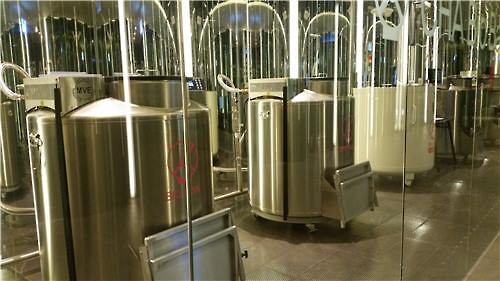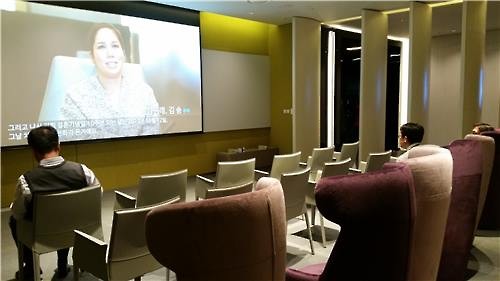
Bio tanks that contain frozen eggs at temperatures of around minus 200 degrees Celsius line the hallway of 37 Oocyte Banking at CHA Fertility Center in central Seoul on March 10, 2016. Each tank has the capacity for 3,000-4,000 eggs initially frozen using liquid nitrogen. (Image : Yonhap)
SEOUL, March 11 (Korea Bizwire) – Song Soo-hyun, 39, recently spent 3.5 million won (US$2,900) to have her eggs frozen at a local fertility center so she could still give birth some day in the future when she finds Mr. Right.
“Next year, I hit my forties. I chose to freeze my eggs because I know I would want kids when I get married,” said Song who has spent most of the past 10 years building her career as a Korean-English simultaneous interpreter.
The case represents an increasing interest among single, working women in their 30s and early 40s in freezing their eggs until they are ready to start a family. As more women join the workforce, they delay getting married and having children due to financial or other reasons.
Oocyte preservation, more commonly known as egg freezing, is a procedure that allows women to beat the biological clock and postpone motherhood. The procedure is often preferred by women who have difficulty getting pregnant or face cancer treatments that can harm fertility. Frozen eggs can usually be stored up to 10 years.
In recent years, there have been more childbirths using frozen eggs globally. Early this year, a Japanese woman in her mid-40s gave birth to a baby, the first such case in the neighboring country, according to CHA Fertility Center.
Many doctors recommend freezing before the age of 37 to have a better chance of conception later on.
“When women reach the age of 35, their ovarian function begins to deteriorate and the ability to reproduce falls sharply after 40,” said Kim Ja-yeon, a doctor at CHA Fertility Center in central Seoul. “As a growing number of working women view marriage as a matter of choice and want to climb the career ladder, egg freezing has emerged as an option for them to have a healthy baby when they marry in their late 30s or 40s.”
The number of single women who had their eggs frozen at CHA Fertility Center’s 37 Oocyte Banking more than quadrupled to 128 last year from 30 in 2013, according to the center.
Seven out of 10 women were aged 35 or older. They opted for the pricey procedure as they plan for or expect a late marriage. Even women in their 20s with high-paying jobs accounted for 14 percent of the total last year, Kim said.
The corresponding data from the country’s two other major fertility centers – Cheil Women’s Healthcare Center and Maria Fertility Center in eastern Seoul – were not available. The three biggest fertility hospitals see most of the Korean egg-freezing applicants.
“As there are no insurance products for egg freezing for single women, we don’t have any national data on it,” a spokesman at the Health Insurance Review & Assessment Service said.
Thus, the daunting price tag remains a major hurdle for single women who are considering the procedure. Government subsidies are only available for married women from low-income brackets. Not a single penny is allowed for singles.
The initial cost for egg freezing can fall between 3.3 million won and 3.8 million won per cycle. One cycle can produce a couple of eggs. It requires more than one cycle to get enough eggs for a good shot at a future pregnancy. There are additional costs of 250,000-300,000 won per year to keep the extracted eggs safely frozen until ready to use. When a woman is ready to use her frozen eggs, the total cost for thawing the egg, fertilization and embryo transfer, can reach 4.5 million won, according to CHA’s 37 Oocyte Banking.
If 10 eggs were extracted from three cycles of egg freezing and the storage period is 10 years, it all adds up to nearly 20 million won, showed calculations by Yonhap News Agency.

Patients watch a video clip that shows successful stories of childbirth using frozen eggs at a waiting room in CHA Fertility Center near Seoul Station on March 9, 2016. (Image : Yonhap)
Global industry giants such as Facebook and Apple foot the bill for female employees when they want to freeze their eggs in extended welfare benefits. But Korean companies have yet to follow suit.
Despite heavy costs and the uncertainty of the procedure, Kim Young-min, a 40-year-old economics professor at Hanyang University, didn’t hesitate to have her eggs frozen last year. She stored them at Cheil Women’s Healthcare Center in central Seoul.
“To me, the cost didn’t matter at all. Now I have another option when I want a baby if I have difficulties getting pregnant. I know the quality of my eggs will deteriorate over time,” said Kim, determined to find the right person in the next five years.
Not all the egg-freezing applicants come of their own will.
“These days, parents send their children in their late 30s to fertility centers to see if egg freezing is possible. Mothers often accompany their long-term single daughters,” said Park Chan-woo at Cheil’s Future Mom Fertility Preservation Center. “Egg preservation is widely accepted in the U.S. and Korea is getting familiar with it through the Internet.”
Given that adoption is less popular in South Korea compared to other countries, the demand for egg freezing looks set to rise, doctors said.
(Yonhap)






